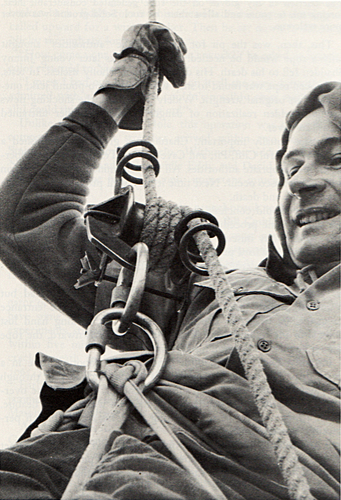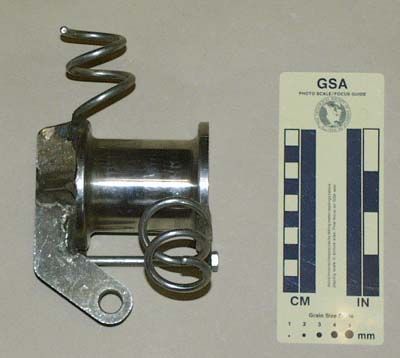Overview
[ Top
| Spool
| Helical spool
| Tapered Spool
| Return to Horizontal Spools
]
Rappelling Log
(#3051)
Technical Details
I made this Rappelling Log in 2021.
This Rappelling Log is 198 mm. tall, 185 mm. wide, 70 mm. thick, and weighs 1023 g.
I chose Catalpa for the wood, not because it is the best choice, but because the first University of Virginia Rappelling Log was made from the limb of a Catalpa tree.
Instead of copying the angle iron side pieces used on the University of Virginia Rappelling Logs, I chose steel channel for its nicer profile.
Rappelling logs should only be used on natural-fiber ropes, preferably high-grade manila.
|
 |
Warning:
Do not use a rappelling log on synthetic ropes. The rope will melt, and may even fuse to the log and strand the caver on rappel. |
 |
|
History
After Bill Cuddington introduced rappel-and-prusik technology in 1952, insufficiently macho cavers cried about the minor discomfort of long dülfersitz rappels. Wah, wah, wah! By 1955, University of Virginia grotto engineers and physicists, tired of all the whining, were working on a solution, and in 1956, Bob Geil developed a practical device: the rappelling log.
Bob’s first log was turned from the limb of a catalpa tree, and it was an instant success with the 5/8 to 3/4—inch (16-19 mm.) manila ropes of the day (cavers had not yet solved the major disadvantages of nylon over manila rope: stretch, spin, cost, and low melting point). Bob’s log was so successful that his younger brother Earl made his own log out of a locust fence post, starting a legend in the process. Later logs were made from used bowling pins from Earl’s bowling alley. About a dozen were made before western cavers started copying the log. Andy Kominski had a real log, complete with bark.
Most rappelling logs angled the side bars so that the chain attachments were close together. Dwight Deal’s log was an exception, and he thought his was the crudest of the lot. When he gave it to me, he wrote, “Gary, I do not think of you as a Person, I think of you as a very specialized museum.”
Rappelling logs work well especially after the rope burns a guide groove into the wood. The better logs were turned with slight tapers toward the center to help guide the rope for the initial burn-in. One caver made the mistake off soaking his log in linseed oil (a common wood varnish) before use. Rappelling into Catawba Murder Hole, rope friction ignited the oil, and the log burned with a three-inch flame. Fortunately, he was not using nylon rope, as that could have been tragic.
Rappelling logs cost about $1.50 to build (in the 1950s). They provide smooth, easily controlled rappels on manila rope. Never use a nylon rope with a rappelling log, as the friction will melt the rope. Stopping will not help, as the rope then fuses to the log. Only use your log on high-quality manila rope, and not on inferior nylon. Rappelling logs allow one to pass knots with ease. Well-made logs test at more than 3200 lbf (14 kN), making them plenty strong for normal use. Rappelling logs remained in use into the mid-1960s, but even as early as 1957-58, Cliff Forman started experimenting with metal spools. These ultimately replaced the log as the state-of-the-art for deep American pit-plunging, at least until the Rappel Rack came along.
[ Top
| Rappelling Log
| Helical spool
| Tapered Spool
| Return to Horizontal Spools
]
Spool
(#427)
Technical Details
My father made this spool for me around 1972.
This spool is 169 mm. tall, 108 mm. wide, 121 mm. thick, and weighs 1261 g. All parts are stainless steel.
 This is what I think of first when I think of a rappel spool. This
spool is based on the spool Bill Cuddington is testing in the
Depths of the Earth (1966, Harper & Row, New York, p.209) photograph. I scaled all the
dimensions from that photograph, then my father had it made out
of stainless steel.
This is what I think of first when I think of a rappel spool. This
spool is based on the spool Bill Cuddington is testing in the
Depths of the Earth (1966, Harper & Row, New York, p.209) photograph. I scaled all the
dimensions from that photograph, then my father had it made out
of stainless steel.
This spool is heavy, mainly because the spool portion has such
a thick wall (about 0.33 in). The coil rope guides keep the rope
running properly, The safety bolt is probably not necessary. I normally
use two or three wraps, and get a very smooth rappel.
Here is what the spool originally looked like:

Many years ago, I broke one of the rope guides and had to weld
it back on. I subsequently broke it again, and replaced it with a temporary one crimped into place until I had time to complete a proper repair. In 2021, Amy Skowronski graciously welded a new helix in place for me. Thank you, Amy!
[ Top
| Rappelling Log
| Spool
| Tapered
| Return to Horizontal Spools
]
Helical Spool
(#3828)
Technical Details
I made this Helical Spool in 2022.
My Storrick Helical Spool is 222 mm. tall, 76 mm. wide, 51 mm. thick, and weighs 667 g.
I used 2” (50 mm.) 6061-T6 round stock to make this spool, and made a simple frame from 9.5 mm. 1018 rod. I milled an 11 mm. wide, 5.5 mm. deep, 13 mm. pitch right-hand helical rope groove, and drilled and threaded the spool for the rods. The jam and acorn nuts secure the rods and act as top horns.
I stamped the spool with my logo.
Spool designs should ensure that the rope does not run over itself and jam. Various designs use assorted guides and pins to prevent this. A very old idea of mine was to put helical grooves in spool to guide the rope. I never saw anyone try this. You can cut the grooves with a round file and an eternity, but I am impatient. Why not mill the grooves? Any milling machine with a short-lead drive mechanism coupling the head to the table lead screw would work.
I milled a right-hand helix for left-hand braking. If I make another, I will probably use a left-hand helix.
As with any device, performance depends on the rope in use. I found that it works fine when I use it on PMI Pit Rope and is fully controllable but slightly fast for my taste on 9 mm. BlueWater II. If I make another, I might add a third turn to give an option for greater friction.
The resulting spool weighs about the same as a typical standard open-frame rack. Not bad for a spool.
Perhaps I should bend the lower guide inward for additional security.
|
 |
Warning:
There is no guarantee that the rope will stay on THIS HELICAL SPOOL. |
 |
|
[ Top
| Rappelling Log
| Spool
| Helical Spool
| Return to Horizontal Spools
]
Tapered Spool
(#3048)
Technical Details
I finished making my Storrick Tapered Spool in 2021.
This Tapered Spool is 159 mm. tall, 88 mm. wide, 82 mm. thick, and weighs 1829 g.
The spool is made out of 12L14. The center is drilled out to reduce weight, and I machined lips at each end to support a holt guide. The arms and bolt guides are made from 1018.
I think it was Gary Bush who told me that that tapering a spool would keep the rope from trying to cross itself. I decided to try it, and turned a spool out of 12L14. I didn't know how much taper I would need, and so I guessed. Eventually I had a momentary cessation of stupidity and remembered that the surface of a cone is intrinsically flat. Knowing this, calculating the required taper is trivial and it was obvious that I had more than enough: only a few degrees are necessary for reasonable spool diameters.
I chose 12L14 for the body since it turns very well, but 12L14 has two bad properties. First, it rusts quickly. Second, and more important for the design of the spool, it is terrible for welding. I needed a different way of attaching the spool to my harness than what I used on my standard spool. I wasn't certain which end of the taper to put main line on, so I wanted a symmetrical arrangement. I chose to copy the design used on the spool that I got from from J. W. Jackson in 2011.
Testing shows that the tapered spool works fine, and that I don't need to add guide coils.
[ Top
| Rappelling Log
| Spool
| Helical spool
| Tapered Spool
]



